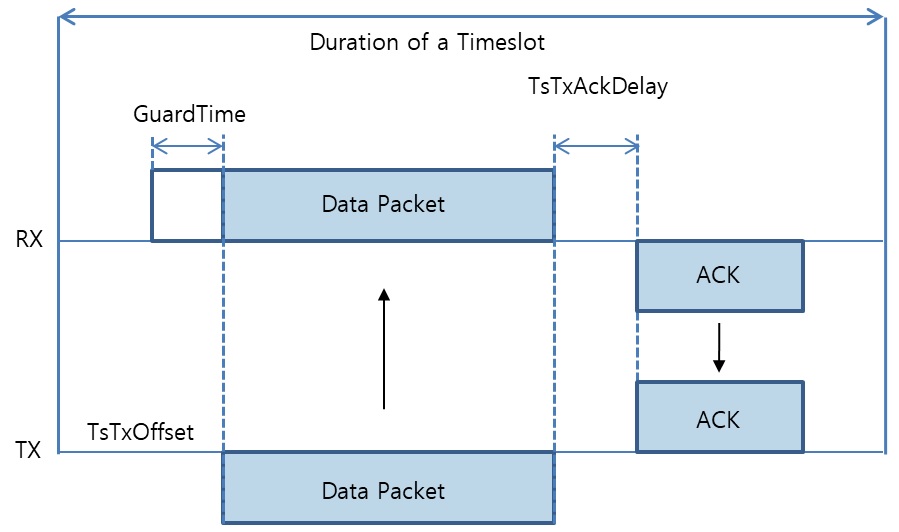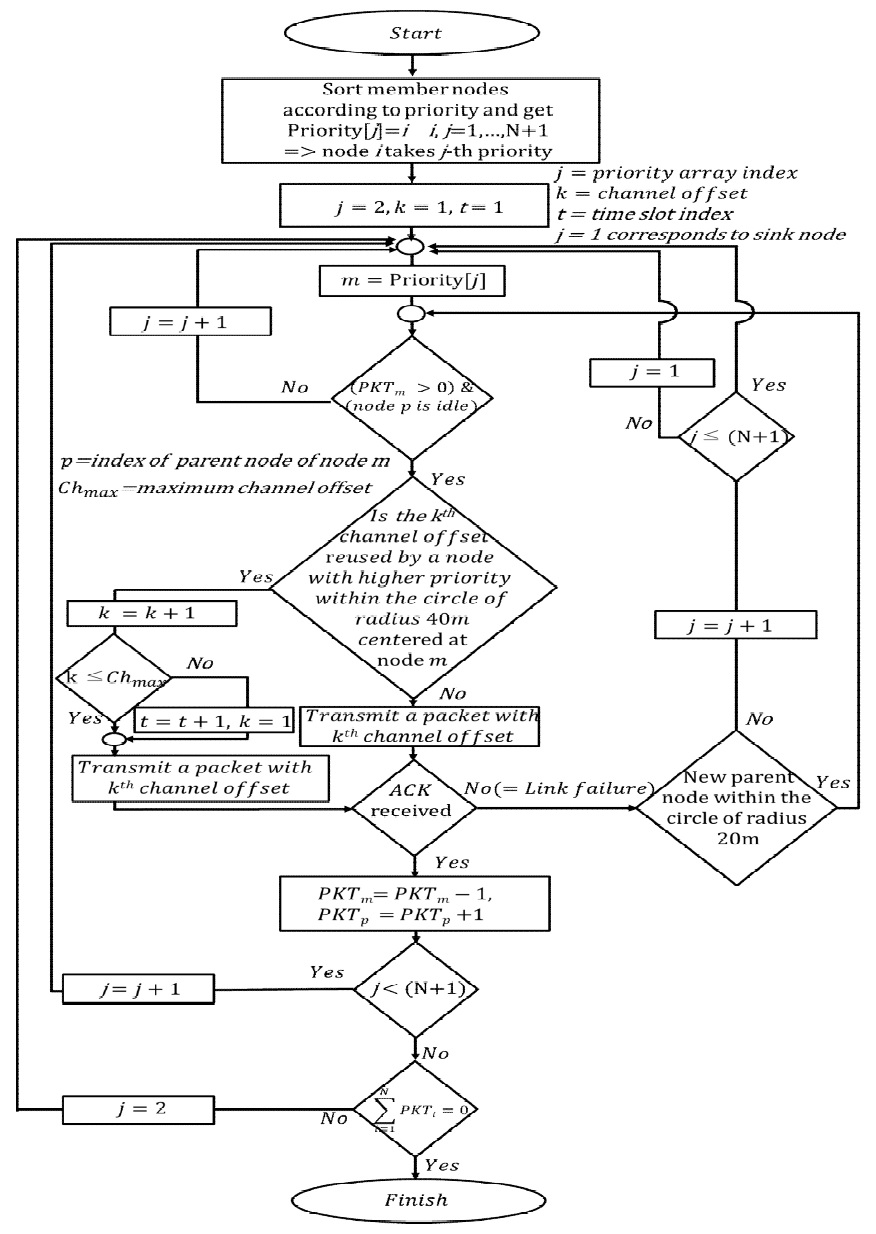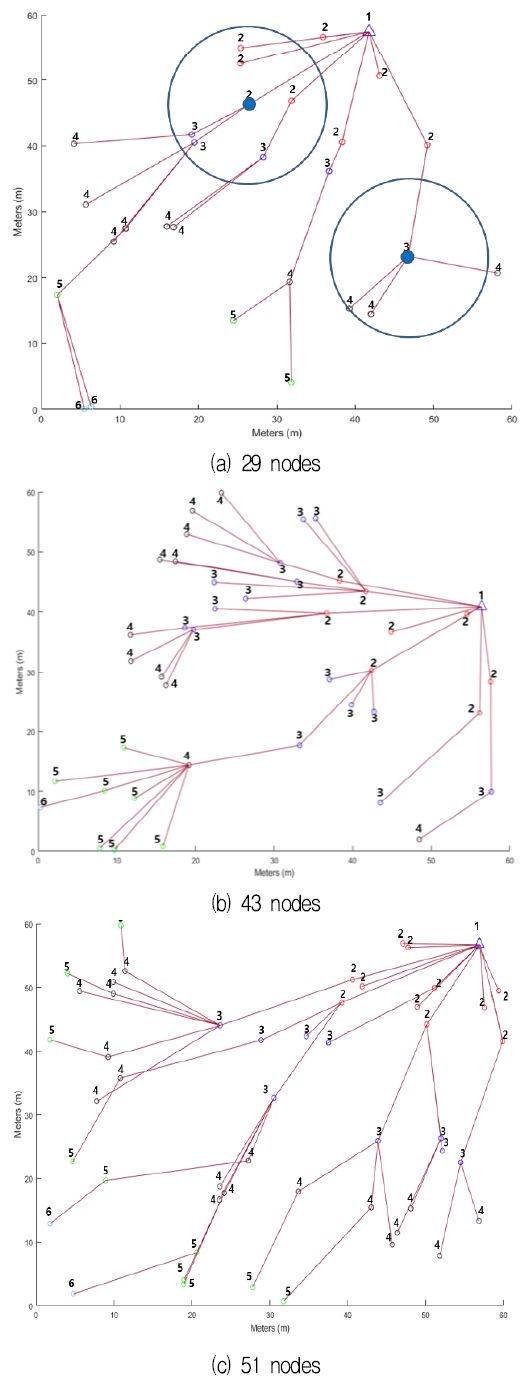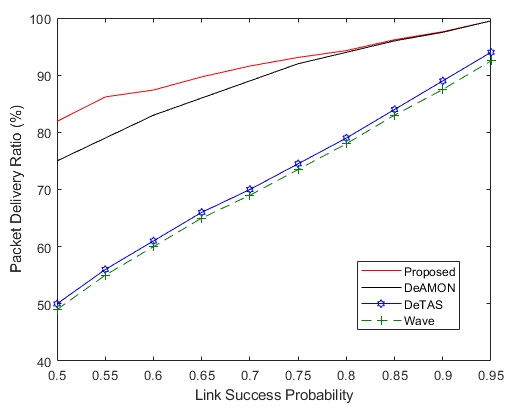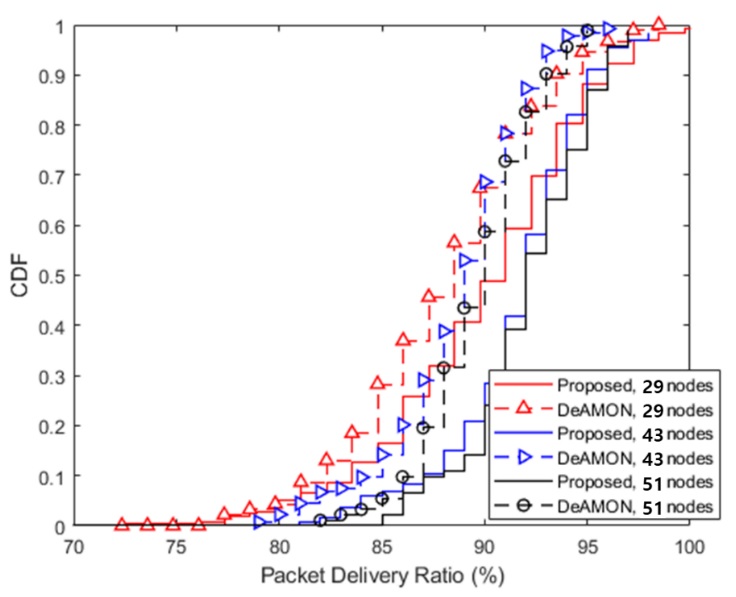
Optimal Link Scheduling Based on Attributes of Nodes in 6TiSCH Wireless Networks
Abstract
In order to implement IPv6 centric Time Slotted Channel Hopping (6TiSCH) wireless network offering features of collision-free link transmission and efficient use of network resource, a link scheduling algorithm utilizing attributes of nodes is proposed. The proposed algorithm attempts to optimize the link scheduling in each slotframe by assigning specific priorities to the member nodes of the network. The priority of link transmission from each node is determined at the sink node by considering the attributes of the node, e.g., its rank assigned within the network, Interference-plus-Noise (IN) measured at the node, and the number of packets of the node to transmit within the slotframe. The attributes of member nodes are transmitted to the sink node over a few time slots in the beginning of each slotframe. Based on the priorities of member nodes, distributed link scheduling is executed. The distributed link scheduling allows non-sequential and parallel transmissions. The performance of the proposed algorithm is compared with those of other recently reported link scheduling algorithms WAVE, DeTAS, and DeAMON in terms of packet delivery ratio and the number of timeslots required to complete all the link transmissions.
초록
충돌 없는 링크 전송 및 네트워크 자원의 효율적인 사용을 특징으로 하는 IPv6 중심 시간 슬롯 형 채널 도약 (6TiSCH) 무선 네트워크를 구현하기 위해, 노드의 속성을 이용하는 링크 스케줄링 알고리즘이 제안한다. 제안 된 알고리즘은 네트워크의 멤버 노드에 특정 우선순위를 할당하여 각 슬롯 프레임에서 링크 스케줄링을 최적화한다. 각 노드로부터의 링크 전송의 우선순위는 노드의 속성, 네트워크 내에 할당 된 순위, 노드에서 측정 된 간섭 플러스 잡음 (IN) 및 패킷의 수를 고려하여 싱크 노드에서 결정된다. 슬롯 프레임 내에서 전송할 노드. 멤버 노드의 속성은 각 슬롯 프레임의 시작 부분에서 몇 개의 시간 슬롯을 통해 싱크 노드로 전송된다. 멤버 노드의 우선순위에 따라 분산 링크 스케줄링이 실행되는데 분산 링크 스케줄링은 비 순차 및 병렬 전송을 허용한다. 제안 된 알고리즘의 성능은 패킷 전송 비율 및 모든 링크 전송을 완료하는 데 필요한 타임 슬롯 수의 측면에서 최근에 보고 된 다른 링크 스케줄링 알고리즘 WAVE, DeTAS 및 DeAMON의 성능과 비교한다.
Keywords:
TSCH, 6TiSCH, industrial IoT, wireless sensor networks, centralized link scheduling, distributed link schedulingⅠ. Introduction
Wireless sensor networks forming the Internet-of-Things have been massively developed lately for various applications[1]-[5] and are expected to play critical roles for emerging Industry 4.0 [6]-[9]. They are required to have high scalability, low latency, high energy efficiency, and decent throughput even in the presence of multi-path fading and jamming which typically exist in industrial applications. To this end, some wireless sensor networks adopt spread spectrum techniques to combat harsh operating conditions. The WirelessHART networks employing the Highway Addressable Remote Transducer (HART) protocol are operated by direct sequence spread spectrum technique [10] and the IPv6 protocol centric 6TiSCH networks run over Time Slotted Channel Hopping (TSCH) mode of the IEEE 802.15.4e standard[11][12]. In TSCH mode, a cell specified in terms of timeslot offset (index) and channel offset becomes the resource unit. The IEEE 802.15.4e TSCH standard specifies only the communication mechanism among nodes without specific scheduling mechanism, leaving room for the development of proprietary scheduling algorithms.
The scheduling algorithms for TSCH wireless networks can be divided into centralized [13]-[15] and decentralized (distributed) [16]-[21] ones. According to the centralized scheduling algorithms, primary controller acting as a sink node knows attributes of member nodes in the TSCH network and determines link scheduling in a non-conflicting manner. A single point of failure, occurred at the sink node, with centralized scheduling algorithm might cause the interruption of entire network operation without prior alerts. A distributed scheduling algorithm is free from single point of failure and provides higher scalability, but it can cause more packet collisions when comparing with centralized scheduling.
When establishing scheduling algorithms of TSCH wireless networks, some factors need to be considered. The factors include network topology, ranks of individual nodes, Signal-to-Interference-plus-Noise Ratio (SINR) measured at the nodes, number of packets to transmit by each node within a predetermined time interval, and type of the scheduling mechanism, i.e., sequential or non-sequential. Various types of network topology [17][22][23] can be used for link transmissions. Tree topology [17] is a reasonable choice for dense networks and allows scalability to a large extent. It is hierarchical in that there are parent-child relationships between nodes in adjacent ranks. A node that has one or more child nodes is the parent node. Each parent node is one rank higher than the child node(s). Rank of each node is considered when scheduling in multi-hop wireless networks [24]. Congestion of data traffic occurs more often with the nodes of the higher rank, which corresponds to the nodes closer to the sink node.
Star topology [22] enables single hop transmission for all the constituent nodes, but it is vulnerable to the single point of failure due to the only hub node in the network. In mesh topology [23][25], each node can act as a router, but as a result, overall network complexity is naturally increased with more nodes. High SINR at a node represents high link quality than a node with low SINR[26]. If the SINR is low, the chance of link failure gets higher and consequently re-transmissions of packets occur more frequently. Low SINR is more often observed with nodes in bottleneck positions of the wireless networks. Therefore, assigning high priority to nodes of low SINR might help improve network throughput. A node with a large number of packets to send to the destined node is critical in achieving the desired level of network throughput [27], because it often affects overall network throughput. Either sequential [16] or non-sequential scheduling mechanism [17] can be considered for link scheduling. Sequential scheduling means that the link scheduling is initiated from each leaf node in a network and packets can be transmitted in parallel. In contrast, the non-sequential scheduling mechanism has no such constraints on the starting point of scheduling.
Many works have investigated link scheduling algorithms for 6TiSCH wireless networks. A decent portion of previous works on the 6TiSCH wireless networks deals with tree topology in spite of potential single point of failure at the sink node, since it fits well to dense networks. Two decentralized scheduling algorithms, which are Aloha-based scheduling algorithm and reservation-based scheduling algorithm, are proposed in [18]. In [16], a Decentralized Adaptive Multi-hop scheduling protocol for 6TiSCH wireless Networks (DeAMON) is investigated. The DeAMON ensures distributed scheduling with the least signaling overhead between neighbor nodes as compared to those of previous studies [16][19]. Moreover, it guarantees sequential scheduling, parallel transmissions, routing-assisted scheduling reconfiguration, robust overprovisioning, and on-the-fly update mechanism ensuring dynamic updates for the backup slots. In [17], a Decentralized Traffic Aware Scheduling (DeTAS) algorithm is proposed for 6TiSCH wireless networks. This decentralized scheduling algorithm is obtained by modifying the centralized scheduling algorithm presented in [13].
To support the decentralized scheduling, child nodes of the border routers gather the information and schedule for their own subtree. Soua et al. proposed WAVE algorithm [19], dealing with a small portion of the slotframe as waves. Because it depends on the broadcasting of the packets over the whole network, signaling cost is relatively high. Hosni et al. proposed a distributed scheduling based on hop distances of the nodes from the border router [20]. They consider upload traffic and download traffic separately and the proposed algorithm includes self-healing methodology to detect and resolve collisions in the network.
A centralized scheduling algorithm is proposed in [13] for non-dynamic multi-hop IEEE802.15.4e networks. It allows parallel transmissions and allocates resources depending on the network topology. For efficient scheduling, the number of packets to be transmitted by each node is considered. A centralized link scheduling based on bandwidth reservation is proposed in [14]. A node has to reserve its bandwidth before joining TSCH wireless network. The node transmits a message, which is forwarded to the sink node, to reserve a bandwidth. The sink node allocates bandwidth for each intermediary hop after receiving the message and adjusts the scheduling. A certifiable resource allocation algorithm is proposed in [15]. Packets are generated only at a source node and they are delivered to the destination node via selected relay node. The relay node is selected in the manner that delay and energy consumption are reduced. However, the algorithm has a limitation with respect to scalability, since the algorithm only focuses on two basic types of topologies, where scalability is hard to come by.
In this paper, a priority-based optimal link scheduling algorithm for 6TiSCH wireless networks is proposed. The proposed algorithm can handle dynamic change of topology associated with link (node) failures. Link scheduling is determined by priorities of member nodes. The priority of a member node is evaluated by the rank of the node, Interference-plus-Noise (IN) measured at the node, and the number of packets to be transmitted within a given slotframe. With approximately equal distances of neighboring nodes from each member node, which is the case of dense nodes for this work, the received power of the desired signal from a child node is roughly the same if identical transmit power is taken for child nodes. Therefore, considering IN is essentially equivalent to taking SINR into account. When a child node takes its turn in link scheduling, all the packets of the child node are transmitted to a parent node. The proposed algorithm is globally optimal in that entire priority assignment is performed only by the sink node, and locally distributed because of distributed scheduling between nodes in adjacent ranks. It can provide optimal link scheduling with dense networks taking tree topology. Although it is a non-sequential scheduling algorithm, the 6TiSCH network does not suffer from collisions, due to the different priorities of member nodes. Main contributions of our work are as follows.
• Unlike previous studies on the 6TiSCH link scheduling, optimal priority is allocated to each member node. The optimal priority of each member node is obtained by an optimization algorithm.
• List of factors affecting the priority of each member node and consequent link scheduling can be flexibly changed. This flexibility provides additional options to network designers.
• Comparing with other link scheduling algorithms for 6TiSCH networks, the proposed algorithm substantially reduces total number of cells required for entire link transmissions. Reduction of cells allows more nodes to be included for larger coverage of 6TiSCH network.
• Proposed algorithm reconfigures the 6TiSCH wireless network when node failure occurs because of poor link quality or depleted battery of a node, and as a result the network retains with alternative node. Capability in avoiding link failure can be converted into sustainable maintenance cost.
Methodology of link scheduling presented in this paper can be used for other types of TSCH wireless networks.
The rest of this paper is organized as follows. Section II describes 6TiSCH network with dense nodes. Section III describes details of the proposed algorithm. Section IV presents the simulation results. Section V concludes this paper.
Ⅱ. System Model Relevant To Proposed Algorithm
System model appropriate for the proposed algorithm is as follows.
- 1) All the member nodes are synchronized with a given slotframe. Distance between a parent node and any child node is set roughly equal and less than 20m.
- 2) Location information of all the member nodes is broadcasted by the sink node in the beginning of initial networking[28].
- 3) The information of the packet sequentially broadcasted, using different cells, from member nodes to the sink node in the beginning of each slotframe consists of node ID, rank of the node, IN measured at the node in the beginning of the given slotframe, and the number of packets to transmit by the node.
- 4) The information of the packet broadcasted from the sink node to member nodes consists of triplets of node ID, priority, and number of packets to transmit by each member node.
- 5) The routing tree is constructed by the Routing Protocol in the network layer for Low power and Lossy networks (RPL) and once the routing tree is constructed, each parent node knows the child nodes connected with it [12][29].
- 6) RPL related signaling occurs on dedicated signaling channels of the slotframe.
- 7) Reconfiguration process takes place when node (link) failure occurs. The purpose of the reconfiguration process is to find alternative parent node. Operation failure of a node can also be detected by the sink node, owing to missing packet broadcasted from the node in the beginning of the slotframe. As a result, the triplet of the node is also omitted in the packet broadcasted from the sink node.
- 8) In order to avoid hidden node problem in the proposed algorithm, each transmitting node considers the priorities of nodes within the circle of radius 40m centered at the node, which is twice the maximum distance between two neighbored nodes. In [16], a link transmission is considered successful, if the receiver of a transmitting node located less than 20m from the receiver is out of the 20m range of transmissions from other nodes on the same channel offset. Our constraint on simultaneous link transmissions on the same channel offset is a little tighter than theirs.
- 9) Reception and transmission of packets at a parent node cannot be executed simultaneously due to the low power operation of node and a parent node cannot receive multiple packets from child nodes even on different channel offsets.
- 10) Link transmission between a parent node and its child node is executed for one packet at a time.
Fig. 1 shows a 6TiSCH wireless network with dense nodes in a tree topology. Rank of the sink node is set to 1, as shown in Fig. 1(a), and communication distance between a parent node and any of its child node(s) is set less than 20m. A Leaf node is defined as the childless node such as nodes 8, 9, 10, 11 of the lowest rank.
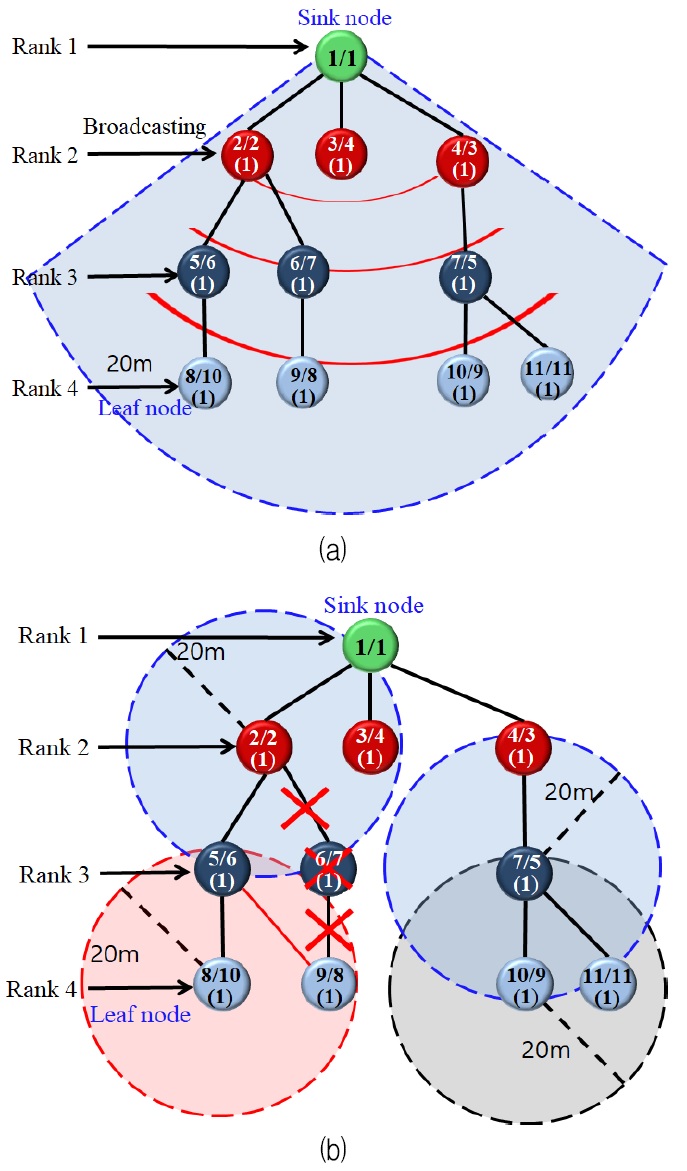
6TiSCH wireless network with dense nodes in tree topology, where each node is labelled by ID/priority (number of packets to transmit). Priority of each node is updated in each slotframe: (a) broadcasting by the sink node for priority assignment; (b) retrieving new parent node when operation failure of old parent node 6 occurs
When a parent node fails in operation with a particular child node, as seen in Fig. 1(b), an alternative parent node within the communication distance of the child node is used instead. Data packet transmission and consequent acknowledgment require a cell which is coordinated with timeslot offset and channel offset.
Total time within a slotframe for all the link transmissions by the proposed algorithm can be expressed as
| (1) |
where Ttot, TIN/membro, Topt/bro, Tcom represent total time taken until the end of all the link transmissions, time taken for measuring IN and sending attribute information of all member nodes to the sink node, time taken for running an optimization algorithm to allocate individual priorities to the member nodes and successive broadcasting to the member nodes, and time needed for completion of all the link transmissions eventually to the sink node, respectively.
The TIN/membro is further divided into a time slot TIN for measuring IN at each member node and time slot(s) Tmembro for broadcasting attributes of member nodes. The Topt/bro is further divided into a time slot Topt for running an optimization algorithm and time slot(s) Tbro for broadcasting priorities of member nodes. It is reasonably assumed here that Ttot is less than the period of a slotframe, thanks to the fair number of nodes in the network and decent benefit from optimized link scheduling, and Topt for running an optimization algorithm takes just one time slot, because of decent processing power of the sink node. Fig. 2 shows an example of Ttot configuration consisting of TIN,Tmembro,Topt,Tbro,Tcom.

Three channel offsets are considered for link scheduling in the 6TiSCH network in Fig. 1. Number of cells for signaling overhead is not properly matched with the number of nodes
Fig. 2 depicts the configuration of slotframe for link transmissions. The first time slot is used for measuring IN at each member node. Each member node having omni-directional antenna transmits a dummy signal with a transmission power equal to that used for packet transmission. Member nodes located at around the center of 6TiSCH network are likely to measure IN level higher than those positioned at the boundary and are subject to higher IN unless appropriate priorities of the link transmissions are assigned to the member nodes. Each member node in the 6TiSCH network measures the IN on the first channel offset over the first time slot. Transmission power for broadcasting attributes from member nodes to the sink node during time slots Tmembro is different from the transmission power required for link transmission from a child node to its parent node, in order to ensure successful reception at the sink node as shown in [30].
During time slots Tmembro, each member node sends a broadcasting packet, shown in Fig. 3(a), consisting of node ID, rank, IN, and the number of packets to transmit to the sink node within a given slotframe, using a distinct cell. The time slot Topt is used to evaluate optimal priorities of member nodes, which are effective only in the given slotframe. Once the priorities of member nodes are evaluated, the sink node broadcasts over the time slot Tbro triplets of node ID, the priority of each node, and the number of packets to transmit, as shown in Fig. 3(b). Similar process of broadcasting and exchanging information before link scheduling is discussed in [31][32]. The main difference of our scheme with regard to theirs lies in priority assignment to member nodes. As a result of priority assignment to member nodes, optimal link scheduling shown in Fig. 2 for the 6TiSCH network in Fig. 1 is enabled. Data transmission starts at the timeslot t7 after initial set-up timeslots. Node 2 with the highest priority, excluding the sink node, starts transmission to the sink node on the first channel offset. Other nodes 4, 3 with priorities 3, 4, respectively, cannot transmit to the sink node which is to receive a packet from node 2. Node 7 with priority 5 knows that it is farther than 40m from the node 2 and transmits to node 4 with the first channel offset. Node 5 with priority 6 cannot transmit to node 2 because the node 2 is to transmit to the sink node and thus cannot receive packet from the node 5 at the same time. Node 6 with priority 7 is not also allowed to transmit to node 2 that is to transmit to the sink node
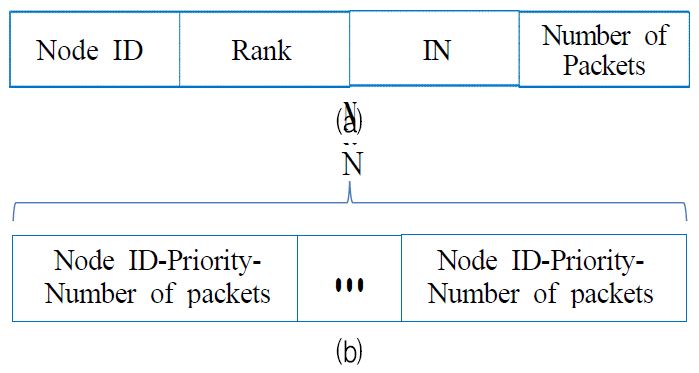
Structure of broadcast packet to/from sink node: (a) packet to sink node; (b) packet from sink node. N represents number of member nodes
Node 9 with priority 8 is not able to use the same channel offset as the one used by node 2, due to geometrical proximity, but still able to transmit to node 6 on the next channel offset. Node 10 with priority 9 is not allowed to transmit to node 7 in the same time slot because node 7 is to transmit to node 4. Node 8 with priority 10 can transmit to node 5 on the third channel offset. Node 11 with priority 11 cannot transmit to node 7 that is to transmit to node 4.
In the timeslot t8, another turn of priority check for link transmission of each node is due. Firstly, node 2 has no more packet to transmit. Node 4 with priority 3 transmits a packet to the sink node. When the node 4 transmits, node 3, node 7 with priorities 4, 5, respectively, cannot transmit packets to their parent nodes. On the other hand, node 5 with priority 6, positioned at a distance greater than 40m from the node 4 can use the same channel offset. When node 5 transmits a packet, node 6 with priority 7 is not allowed to transmit due to a common parent node. Node 9 with priority 8 has no more packet to transmit. Node 10 is within 40m distance range from the node 5, so same channel offset is not allowed to be used. However, node 10 can transmit a packet on another channel offset. Node 11, on the other hand, cannot transmit to the parent node 7 because of node 10. Similar link scheduling is repeated in succeeding timeslots.
Fig. 4 shows a 10ms time slot compatible with 6TiSCH network standard. The data packet is transmitted by a transmitting node after the TsTxOffset time interval.
The receiver listens to incoming packets at starting point of GuardTime which is typically 1ms long and starts before TsTxOffset ends. Once data packet is successfully received, an “ACK” signal is transmitted from Rx to Tx after the TsTxAckDelay time interval. Therefore, packet transmission by a child node and acknowledgement by the parent node are executed over a single time slot.
A node failure occurs when the channel condition is bad, i.e., SINR is low or the battery is completely discharged. Fig. 1(b) shows that parent node 6 that has experienced a node failure is replaced with parent node 5 for child node 9. Selection of new parent node among parent node candidates can be done by considering priorities of parent node candidates. The one with the least difference of priority value as compared to that of old parent node can be chosen as the new parent node. By this way of selection, overall link scheduling is not significantly affected.
Fig. 5 shows updated link scheduling with a failure of node 6 shown in Fig. 1. When node 9 receives NAK from node 6 in time slot t7, node 9 transmits the packet to node 5 in time slot t9 and node 5 transmits to node 2 in time slot t12.
Ⅲ. Link Scheduling By Proposed Algorithm
For evaluation of node priority, node attributes consisting of rank, IN, and the number of packets to transmit are considered. The rank attribute is important since the bottleneck problem with data traffic usually occurs with high rank nodes near the sink node. Every child node has packets generated for transmission to its parent node. Therefore, high rank nodes have more packets to transmit in each slotframe and thus have to take higher priorities, compared with lower rank nodes. The IN factor is also considered for the scheduling.
When a node measures a high IN, it is more likely to be a bottleneck node affecting overall throughput of the 6TiSCH network. From this viewpoint, nodes with higher IN values can be assigned with higher priorities to make their packets transmitted in early time slots of slotframe [33]. In [26], a distributed scheduling algorithm for the packet transmission over a multi-hop wireless network is investigated, considering the SINR values of nodes for priority queuing process.
The Number of packets to transmit is another one to consider for the link scheduling. A node with more packets to transmit requires more cells for scheduling, requesting high priority for maintaining an acceptable level of throughput. In [27], an opportunistic time slot allocation algorithm based on the priorities of nodes, which are determined by the number of packets to transmit to their parent nodes, is presented.
The three attributes, rank, IN, and the number of packets to transmit, are three constituent objectives for the optimization. Priorities of N member nodes determined by the ranks of the nodes are obtained as
| (2) |
where pi ,ri represent priority of node i, rank of node i, respectively. Note that the sink node, which takes the highest priority and becomes rank 1, is also considered in (2). Optimal priorities of N member nodes are found among all the possible non-conflicting priority assignments. The sum in (2) is increased when the priorities of the high rank nodes become higher. Priorities of member nodes determined by the IN values are obtained as
| (3) |
where INi indicates the IN measured at node i during the first time slot. For simulations, free space equation is used for evaluation of interference from node j to node i. Interference from member node j to member node i is given in [34] as follows
| (4) |
where λ, dij, PT, γ, β represent wavelength, distance between node i and node j, transmit power, Rayleigh block fading random variable [20], parameter characterizing interference model, respectively. The INi measured at node i is given as
| (5) |
Priorities of all the nodes determined by the number of packets to transmit within given slotframe are evaluated by
| (6) |
where PKTi is the number of packets to transmit by node i. From (2), (3), (6), priorities of member nodes for the proposed algorithm are found by an optimization, based on the combined objectives, as following
| (7) |
where W1,W2,W3 are weights for individual objectives and subject to W1 +W2 +W3 = 1. Since values of are much greater than the value of , normalized objectives are used for (7). Let , , , then (7) is rewritten as
| (8) |
Optimal priorities of nodes are obtained by the genetic algorithm [35].
After the broadcasting is finished, link scheduling is initiated with the priorities of the nodes determined by the sink node. Link between parent node and child node is established according to the priority of child node. Based on priorities of nodes, non-sequential scheduling is performed.
The proposed algorithm is a decentralized link scheduling. Since link scheduling entirely depends on priorities of member nodes, heavy signaling overhead, which is often required for distributed scheduling, is not involved. Furthermore, it is robust even with link failures, thanks to the likely presence of alternative parent node having similar priorities. Flowchart of link scheduling by the proposed algorithm is shown in Fig. 6.
Ⅳ. Simulation Results
4.1 Simulation Scenario
Simulation is conducted to confirm the performance of the link scheduling by the proposed algorithm. Member nodes of the 6TiSCH network are Poisson distributed over 60m✕60m square area.
Operating conditions of the proposed algorithm are adopted from [16]. Transmit power PT is set to 0.002Watt (3dBm). Wavelength λ is set to 0.125m, since the frequency band for typical 6TiSCH networks is around 2.4GHz. The parameter β in (4) is set to 0. Scale parameter σ for Rayleigh fading is set to 1. Range of the number of packets to transmit by each member node in a slotframe is 1~3.
Fig. 7 shows 6TiSCH networks considered for simulations with different number of member nodes. Rank of each node in each 6TiSCH network with different number of nodes is marked. Distance between a parent node and a child node is within 20m. Circles shown in Fig. 7(a) indicate those with 20m radius centered at rank 2 node and rank 3 node. Nodes located inside the left circle might have higher IN which helps them take higher priorities as compared to those located within the right circle.
Weighting factors used for individual objectives shown in (8) are W1=0.5, W2=0.2 and W3=0.3, unless otherwise stated. Simulation results obtained by other link scheduling algorithms are used for comparisons. Number of time slots for TIN/membro +Topt/bro is taken as 7 with 3 and 16 channel offsets. Considering small amount of information broadcasted by the sink node to member nodes, Tbro can be safely set to 1 time slot.
4.2 Link Scheduling Performance of Proposed Algorithm
Fig. 8 shows the Packet Delivery Ratio (PDR) performance of the proposed algorithm according to Link Success Probability (LSP). The proposed algorithm as well as DeAMON performs much better than the DeTAS and WAVE because of reconfigurability when a parent node suffers a node failure. The proposed algorithm and DeAMON can find alternative parent node unlike DeTAS and Wave.
The proposed algorithm performs better than DeAMON when LSP is below 0.8, due to its ability in non-sequential link transmission. Sequential transmission suffers multiple packet loss when a parent node along the route to the sink node undergoes a node failure and an alternative parent node is not found. Non-sequential transmission according to the priorities of nodes reduces the chance of multiple packet loss. Note that nodes of low rank that initiate sequential transmissions typically take low priorities by the proposed algorithm. As a result, when the LSP is less than 0.8, the proposed algorithm performs better than the others.
Reliability performance can be evaluated by considering the Cumulative Distribution Function (CDF) of PDR. Fig. 9 shows the CDF of PDR with the proposed algorithm and DeAMON when LSP = 0.65. According to [16], reliability performances of DeTAS and Wave are significantly worse than DeAMON, so they are not presented in Fig. 9 for comparison.
It is shown in the figure that the proposed algorithm consistently outperforms the DeAMON in reliability performance. Reliability performance is improved with more member nodes, because alternative parent node is more likely found when node failure occurs with common service area.
Simulation results demonstrating cell usage of the proposed algorithm and DeAMON when LSP=0.65 are shown in Fig. 10. The Number of available channel offsets are set to 3 and 16. Fig. 10 shows that the proposed algorithm can send all the packets of member nodes to the sink node with a reduced number of time slots.
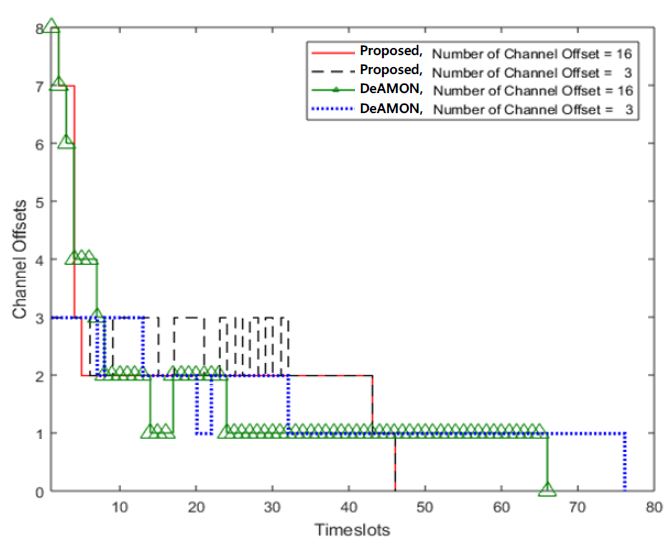
Comparison of proposed algorithm with DeAMON in terms of cell usage when number of available channel offsets is 3 and 16 for 6TiSCH network in Fig. 7(a)
When the number of channel offsets is limited to 3, the number of time slots necessary for the proposed algorithm is 53(=46 in Fig. 10), including the first seven time slots for priority assignment, whereas the number of time slots used for the DeAMON is 76.
When the number of channel offsets is 16, the proposed algorithm requires 53 time slots, including the first seven time slots, whereas the DeAMON uses 66 time slots. Because of lower PDR with the DeAMON, number of cells required for total link transmissions might be lower than that of the proposed algorithm. Simulation results of cell usage shows that cell utilization in each timeslot of the proposed algorithm is mostly higher than that of the DeAMON. This is mainly due to parallel transmissions in a non-conflict way, thanks to the allocation of proper priorities to member nodes by the proposed algorithm. Considering that cell usage is directly connected to the latency, the proposed algorithm achieves lower average latency than the DeAMON.
Cell usage of the proposed algorithm and DeAMON with different values of LSP is shown in Fig. 11. When LSP=1.0, the proposed algorithm requires only 53 time slots, including the first seven time slots of the slotframe, whereas the DeAMON needs 66 time slots. When LSP=0.7, the proposed algorithm uses 38 time slots, including the first seven time slots, whereas DeAMON needs 45 time slots. It is seen in the figure that the number of timeslots required for total link transmissions tends to increase with higher LSP, because with higher LSP more packets need to be transmitted to the sink node.

Comparison of POL6 with DeAMON in terms of cell usage when LSP=1.0 and LSP=0.7 for 6TiSCH network in Fig. 7(a)
Simulation results to determine the best weighting factors are shown in Fig. 12. It is shown that the number of time slots is identical with different sets of weighting factors. However, the cell usage is different depending on specific weighting factors. The cell usage is 106 when weighting factors for rank, IN, number of packets are 0.8, 0.1, 0.1, respectively.
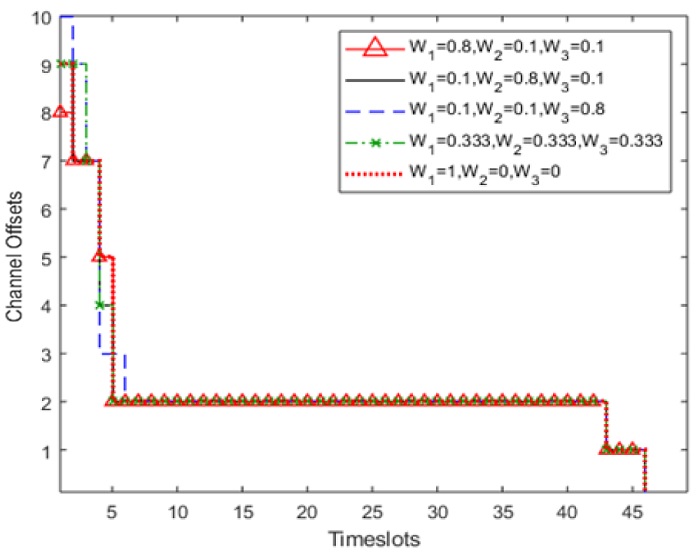
Cell usage according to weight factors W1, W2 and W3 for rank, IN, and number of packets, respectively, with 6TiSCH network in Fig. 7(a)
It is also 106 when weighting factors for rank, IN, number of packets are 0.1, 0.8, 0.1, respectively. However, the cell usage is 109 when weighting factors for rank, IN, number of packets are 0.1, 0.1, 0.8, respectively. Though it is seen that rank and IN are a little more essential attributes than the number of packets to transmit, differences among three cases are not clearly evident.
V. Conclusion
A priority-based link scheduling for the 6TiSCH network is proposed in this paper. The proposed algorithm attempts to optimize the link scheduling in each slotframe by assigning specific priorities to the member nodes. The priority of a member node is evaluated at the sink node based on the node specific attributes. Based on the attributes of the node, an optimal priority is assigned by the sink node. Based on the priorities of individual nodes, distributed link scheduling from child node(s) to one rank higher parent node is executed. It is shown by simulation results that PDR performance of the proposed algorithm is better than the DeAMON, DeTAS, and Wave. Also, the number of timeslots required by the proposed algorithm is smaller than that for the DeAMON, representing more compact use of cells over timeslots. The proposed algorithm of PDF is PDR=83% and the Daemon of PDR is 75% at LSP=0.5.
Acknowledgments
The authors gratefully acknowledge the support from the Energy Cloud R&D Program through the National Research Foundation of Korea (NRF) funded by the Ministry of Science, ICT (No.2019M3F2A1073314).
References
-
J. Gubbi, R. Buyya, S. Marusic, and M. Palaniswami, "Internet of Things (IoT): A vision, architectural elements, and future directions", Future Generation Computer Systems-the International Journal of Escience, Vol. 29, No. 7, pp. 1645-1660, Sep. 2013.
[https://doi.org/10.1016/j.future.2013.01.010]

-
Z. Q. He, J. L. Yang, X. D. Wang, Y. Liu, and Y. Rong, "Channel Estimation of MIMO Relay Systems With Multiple Relay Nodes", IEEE Access, Vol. 5, pp. 27649-27658, Nov. 2017.
[https://doi.org/10.1109/ACCESS.2017.2775202]

-
S. D. T. Kelly, N. K. Suryadevara, and S. C. Mukhopadhyay, "Towards the Implementation of IoT for Environmental Condition Monitoring in Homes", IEEE Sensors Journal, Vol. 13, No. 10, pp. 3846-3853, Oct. 2013.
[https://doi.org/10.1109/JSEN.2013.2263379]

-
F. Tao, Y. Zuo, L. D. Xu, and L. Zhang, "IoT-Based Intelligent Perception and Access of Manufacturing Resource Toward Cloud Manufacturing", IEEE Transactions on Industrial Informatics, Vol. 10, No. 2, pp. 1547-1557, May 2014.
[https://doi.org/10.1109/TII.2014.2306397]

-
C. M. G. Algora, V. A. Reguera, N. Deligiannis, and K. Steenhaut, "Review and Classification of Multichannel MAC Protocols for Low-Power and Lossy Networks", IEEE Access, Vol. 5, pp. 19536-19561, Sep. 2017.
[https://doi.org/10.1109/ACCESS.2017.2748178]

-
D. Hortelano, T. Olivares, M. C. Ruiz, C. Garrido-Hidalgo, and V. Lopez, "From Sensor Networks to Internet of Things. Bluetooth Low Energy, a Standard for This Evolution", Sensors, Vol. 17, No. 2, pp. 372, Feb. 2017.
[https://doi.org/10.3390/s17020372]

-
C. C. Lin, D. J. Deng, Z. Y. Chen, and K. C. Chen, "Key Design of Driving Industry 4.0: Joint Energy-Efficient Deployment and Scheduling in Group-Based Industrial Wireless Sensor Networks", IEEE Communications Magazine, Vol. 54, No. 10, pp. 46-52, Oct. 2016.
[https://doi.org/10.1109/MCOM.2016.7588228]

-
D. Georgakopoulos, P. P. Jayaraman, M. Fazia, M. Villari, and R. Ranjan, "Internet of Things and Edge Cloud Computing Roadmap for Manufacturing", IEEE Cloud Computing, Vol. 3, No. 4, pp. 66-73, Jul.-Aug. 2016.
[https://doi.org/10.1109/MCC.2016.91]

-
S. H. Bouk, H. B. Song, W. Ejaz, S. H. Ahmed, and D. B. Rawat, "IEEE Access Special Section Editorial: Future Networks: Architectures, Protocols, and Applications", IEEE Access, Vol. 5, pp. 27831-27835, Sep. 2017.
[https://doi.org/10.1109/ACCESS.2017.2783120]

-
S. Petersen and S. Carlsen, "WirelessHART Versus ISA100.11a The Format War Hits the Factory Floor", IEEE Industrial Electronics Magazine, Vol. 5, No. 4, pp. 23-34, Dec. 2011.
[https://doi.org/10.1109/MIE.2011.943023]

-
D. Dujovne, T. Watteyne, X. Vilajosana, and P. Thubert, "6TiSCH: Deterministic IP-Enabled Industrial Internet (of Things)", IEEE Communications Magazine, Vol. 52, pp. 36-41, Dec. 2014.
[https://doi.org/10.1109/MCOM.2014.6979984]

- "IEEE Standard for Low-Rate Wireless Networks", IEEE Std 802.15.4-2015 (Revision of IEEE Std 802.15.4-2011), pp. 1-709, Apr. 2016.
-
M. R. Palattella, N. Accettura, L. A. Grieco, G. Boggia, M. Dohler, and T. Engel, "On Optimal Scheduling in Duty-Cycled Industrial IoT Applications Using IEEE802.15.4e TSCH", IEEE Sensors Journal, Vol. 13, No. 10, pp. 3655-3666, Oct. 2013.
[https://doi.org/10.1109/JSEN.2013.2266417]

-
K. H. Choi and S. H. Chung, "A New Centralized Link Scheduling for 6TiSCH Wireless Industrial Networks", International Conference on Next Generation Wired/Wireless Networking, St. Petersburg, Russia, pp. 360-371, Sep. 2016.
[https://doi.org/10.1007/978-3-319-46301-8_30]

-
Q. Wang, K. Jaffres-Runser, Y. Xu, and J. L. Scharbarg, "A certifiable resource allocation for real-time multi-hop 6TiSCH wireless networks", Factory Communication Systems (WFCS), Trondheim, Norway, pp. 1-9, Jun. 2017.
[https://doi.org/10.1109/WFCS.2017.7991957]

-
A. Aijaz and U. Raza, "DeAMON: A Decentralized Adaptive Multi-Hop Scheduling Protocol for 6TiSCH Wireless Networks", IEEE Sensors Journal, Vol. 17, No. 20, pp. 6825-6836, Oct. 2017.
[https://doi.org/10.1109/JSEN.2017.2746183]

-
N. Accettura, E. Vogli, M. R. Palattella, L. A. Grieco, G. Boggia, and M. Dohler, "Decentralized Traffic Aware Scheduling in 6TiSCH Networks: Design and Experimental Evaluation", IEEE Internet of Things Journal, Vol. 2, No. 6, pp. 455-470, Dec. 2015.
[https://doi.org/10.1109/JIOT.2015.2476915]

-
A. Tinka, T. Watteyne, K. Pister, and A. M. Bayen, "A decentralized scheduling algorithm for time synchronized channel hopping", International Conference on Ad Hoc Networks, Victoria, BC, Canada, pp. 201-216, Aug. 2010.
[https://doi.org/10.1007/978-3-642-17994-5_14]

-
R. Soua, P. Minet, and E. Livolant, "Wave: a distributed scheduling algorithm for convergecast in IEEE 802.15.4e TSCH networks", Transactions on Emerging Telecommunications Technologies, Vol. 27, No. 4, pp. 557-575, Apr. 2016.
[https://doi.org/10.1002/ett.2991]

-
I. Hosni and F. Theoleyre, "Self-healing distributed scheduling for end-to-end delay optimization in multihop wireless networks with 6TiSCh", Computer Communications, Vol. 110, pp. 103-119, Sep. 2017.
[https://doi.org/10.1016/j.comcom.2017.05.014]

-
A. Ndikumana, S. Ullah, K. Thar, N. H. Tran, B. J. Park, and C. S. Hong, "Novel Cooperative and Fully-Distributed Congestion Control Mechanism for Content Centric Networking", IEEE Access, Vol. 5, pp. 27691-27706, Nov. 2017.
[https://doi.org/10.1109/ACCESS.2017.2778339]

-
O. Iova, F. Theoleyre, T. Watteyne, and T. Noel, "The Love-Hate Relationship between IEEE 802.15.4 and RPL", IEEE Communications Magazine, Vol. 55, No. 1, pp. 188-194, Jan. 2017.
[https://doi.org/10.1109/MCOM.2016.1300687RP]

-
E. Municio and S. Latre, "Decentralized broadcast-based scheduling for dense multi-hop TSCH networks", MobiArch '16: Proceedings of the Workshop on Mobility in the Evolving Internet Architecture, New York City, USA, pp. 19-24, Oct. 2016.
[https://doi.org/10.1145/2980137.2980143]

-
V. Kanodia, C. Li, B. Sadeghi, and E. Knightly, "Distributed multi-hop scheduling and medium access with delay and throughput constraints", In the 7th annual international conference on Mobile computing and networking, Rome Italy, pp. 200-209, Jul. 2001.
[https://doi.org/10.1145/381677.381697]

-
A. Aijaz and A. H. Aghvami, "Cognitive Machine-to-Machine Communications for Internet-of-Things: A Protocol Stack Perspective", IEEE Internet of Things Journal, Vol. 2, No. 2, pp. 103-112, Apr. 2015.
[https://doi.org/10.1109/JIOT.2015.2390775]

-
H. P. Shiang and M. van der Schaar, "Multi-user video streaming over multi-hop wireless networks: A distributed, cross-layer approach based on priority queuing", IEEE Journal on Selected Areas in Communications, Vol. 25, No. 4, pp. 770-785, May 2007.
[https://doi.org/10.1109/JSAC.2007.070513]

-
O. Mabrouk, H. Idoudi, I. Amdouni, R. Soua, P. Minet, and L. Saidane, "OTICOR: Opportunistic Time Slot Assignment in Cognitive Radio Sensor Networks", In Advanced Information Networking and Applications (AINA), 2014 IEEE 28th International Conference on, Victoria, BC, Canada, pp. 790-797, May 2014.
[https://doi.org/10.1109/AINA.2014.96]

-
O. Gaddour and A. Koubaa, "RPL in a nutshell: A survey", Computer Networks, Vol. 56, No. 14, pp. 3163-3178, Sep. 2012.
[https://doi.org/10.1016/j.comnet.2012.06.016]

-
J. H. Choi, F. T. Dagefu, B. M. Sadler, and K. Sarabandi, "Low-Power Low-VHF Ad-Hoc Networking in Complex Environments", IEEE Access, Vol. 5, pp. 24120-24127, Nov. 2017.
[https://doi.org/10.1109/ACCESS.2017.2771342]

-
A. K. Demir and S. Bilgili, "DIVA: a distributed divergecast scehduling algorithm for IEEE 802.15.4e TSCH networks", Wireless Networks, Vol. 25, No. 2. pp. 625-635, Feb. 2019.
[https://doi.org/10.1007/s11276-017-1580-4]

-
T. P. Duy, T. Dinh, and Y. Kim, "A rapid joining scheme based on fuzzy logic for highly dynamic IEEE 802.15.4e time-slotted channel hopping networks", International Journal of Distributed Sensor Networks, Vol. 12, No. 8, Aug. 2016.
[https://doi.org/10.1177/1550147716659424]

-
P. Zand, K. Das, E. Mathews, and P. Havinga, "A distributed management scheme for supporting energy-harvested I/O devices", Proceedings of the 2014 IEEE Emerging Technology and Factory Automation (ETFA), Barcelona, Spain, pp. 1-10, Sep. 2014.
[https://doi.org/10.1109/ETFA.2014.7005210]

-
A. Temesváry, "Self-Configuration of Antenna Tilt and Power for Plug & Play Deployed Cellular Networks", 2009 IEEE Wireless Communications and Networking Conference, Budapest, Hungary, pp. 1-6, Apr. 2009.
[https://doi.org/10.1109/WCNC.2009.4917961]

-
S. B. He, J. M. Chen, F. C. Jiang, D. K. Y. Yau, G. L. Xing, and Y. X. Sun, "Energy Provisioning in Wireless Rechargeable Sensor Networks", IEEE Transactions on Mobile Computing, Vol. 12, No. 10, pp. 1931-1942, Oct. 2013.
[https://doi.org/10.1109/TMC.2012.161]

-
K. Deb, A. Pratap, S. Agarwal, and T. Meyarivan, "A fast and elitist multiobjective genetic algorithm: NSGA-II", IEEE Transactions on Evolutionary Computation, Vol. 6, No. 2, pp. 182-197, Apr. 2002.
[https://doi.org/10.1109/4235.996017]


2015 : BS degree, in Dept. of electronics and information engineering, Korea University
2018 : MS degree, in Dept. of Cho Chun Shik Graduate School of Green Transportation, KAIST
2018 ~ present : student of Ph.D degree, in Dept. of Cho Chun Shik Graduate School of Green Transportation, KAIST
Research interests : optimization, sensor network, communication system, power system, neural network

1986 : BS degree, in Dept. of electrical engineering, Seoul National University
1988 : MS degree, in Dept. of electrical engineering, Seoul National University
1997 : Ph.D degree, in Dept. of electrical engineering, Polytechnic University
Present : Professor, in Dept. of Cho Chun Shick Graduate School of Green Transportation, KAIST
Research interests : optimization of communication system operation and transportation system development with embedded artificial intelligence

2015 : BS degree, in Dept. of electronics and computer engineering, the Federal University of Rio de Janeiro
2017 : MS degree, in Dept. of electrical engineering, the Federal University of Rio de Janeiro
2017 ~ present : student of Ph.D degree, in Dept. of Cho Chun Shik Graduate School of Green Transportation, KAIST
Research interests : applied deep learning, digital signal processing, reinforcement learning, robotics

1987 : BS degree, in Dept. of electrical engineering, Seoul National University
1989 : MS degree, in Dept. of electrical engineering, Seoul National University
1995 : Ph.D degree, in Dept. of electrical engineering, Seoul National University
Present : Professor, in Dept. of Energy IT, Gachon University
Research interests : the smart grid, supergrid, renewable energy, digitalization of electric power, and energy policy

1988 : BS degree, Ewha Womans University
1990 : MS degree, Ewha Womans University
199 4: MS degree, Columbia University
2001 : Ph.D degree, Columbia University
Present : Professor, in Dept. of Orthodontics, Chonnam National University School of Dentistry
Research interests : Numerical and statistical analysis in cohort studies

